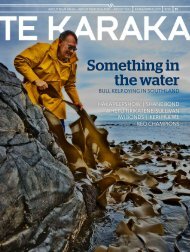Maraka! Maraka! Otautahi rises from the ruins - te karaka
Maraka! Maraka! Otautahi rises from the ruins - te karaka
Maraka! Maraka! Otautahi rises from the ruins - te karaka
You also want an ePaper? Increase the reach of your titles
YUMPU automatically turns print PDFs into web optimized ePapers that Google loves.
presence when <strong>the</strong>y’ve articula<strong>te</strong>d that and<br />
it still holds true if you are a weaver; but of<br />
course, not everyone is a weaver and things<br />
do come to <strong>the</strong> end of <strong>the</strong>ir lives. Now though,<br />
we can give a garment ano<strong>the</strong>r hundred years<br />
of life, so that it can bring pleasure to future<br />
generations,” she says.<br />
The preservation and conservation though<br />
is about more than just pleasure. As Ranui<br />
points out, for some, those early garments are<br />
<strong>the</strong> only clue to <strong>the</strong> thinking and work practices<br />
“of <strong>the</strong> hands of those times.”<br />
“Ao<strong>te</strong>aroa Moananui-ā-Kiwa was a very<br />
forward-thinking group for its time. It understood<br />
<strong>the</strong> need for taonga conservation and<br />
<strong>the</strong> need to <strong>te</strong>st and record and to look for<br />
what might help weavers of <strong>the</strong> future. That<br />
includes research into <strong>the</strong> plants we use, like<br />
harakeke, which has been shown to have<br />
different fibre con<strong>te</strong>nt depending on where in<br />
New Zealand it is grown.”<br />
Ranui who is based in Christchurch also restores korowai.<br />
“Restoration is different to conservation, but of course <strong>the</strong> two<br />
are in<strong>te</strong>rconnec<strong>te</strong>d. If a whānau wants to continue wearing a garment<br />
that is basically sound, I can repair and restore it. Aunty Tiny Wright’s<br />
(Ngāi Tahu) kahu kiwi is a good example. Te Papa provided <strong>the</strong> fea<strong>the</strong>rs<br />
for a small amount of repair and restoration to <strong>the</strong> 120 year-old<br />
garment, and now, if her whānau take good care of it, <strong>the</strong>y’ll still be<br />
wearing it 120 years <strong>from</strong> now.<br />
“The future of our taonga lies with people like Rangi. It’s wonder-<br />
CaRing FOR<br />
mĀORi TeXTiLes<br />
iwi and whānau are in possession of many<br />
forms of taonga in <strong>the</strong>ir wharenui and in<br />
homes around <strong>the</strong> country. <strong>the</strong>se include<br />
woven treasures like ke<strong>te</strong> (baskets),<br />
piupiu, whāriki (mats) and kākahu (cloaks),<br />
which are made <strong>from</strong> plant ma<strong>te</strong>rial and<br />
of<strong>te</strong>n include fea<strong>the</strong>rs, wool and hair.<br />
<strong>the</strong> following s<strong>te</strong>ps are essential for caring<br />
for such i<strong>te</strong>ms.<br />
• identify <strong>the</strong> taonga and <strong>the</strong> ma<strong>te</strong>rials<br />
<strong>the</strong>y are made of and assess <strong>the</strong><br />
condition of <strong>the</strong>se ma<strong>te</strong>rials. handle<br />
<strong>the</strong>m accordingly. You may need expert<br />
help in this, especially if <strong>the</strong>y are fragile,<br />
which is where <strong>the</strong> <strong>te</strong>am at <strong>te</strong> Papa’s<br />
National Services <strong>te</strong> Paerangi can<br />
be invaluable. Anyone wanting <strong>the</strong>ir<br />
assistance should contact gavin Reedy<br />
on 0508 678 743 or email<br />
gavinr@<strong>te</strong>papa.govt.nz.<br />
• Maintain good conservation practice<br />
when handling, storing or displaying<br />
taonga, preferably by wearing la<strong>te</strong>x<br />
gloves and creating acid-free cardboard<br />
boxes for <strong>the</strong> storage of rolled i<strong>te</strong>ms.<br />
54 <strong>te</strong> KaraKa MaKarIrI 2011<br />
“ Ao<strong>te</strong>aroa<br />
Moananui-ā-<br />
Kiwa was a very<br />
forward-thinking<br />
group for its time.<br />
It understood <strong>the</strong><br />
need for taonga<br />
conservation and<br />
<strong>the</strong> need to <strong>te</strong>st<br />
and record and to<br />
look for what might<br />
help weavers of <strong>the</strong><br />
future.”<br />
RANui NgARiMu<br />
Ngāi tahu,<br />
Ngāti Mutunga,<br />
weaving expert<br />
• Always roll garments and mats; never<br />
fold <strong>the</strong>m.<br />
• Keep taonga out of bright light. Sunlight<br />
is very damaging and causes colours<br />
to fade and fibres to become dry and<br />
brittle.<br />
• heat also dries out <strong>te</strong>xtiles; while too<br />
much moisture in <strong>the</strong> air can lead<br />
to mould and mildew. dust, moths,<br />
silverfish and mi<strong>te</strong>s are also a problem<br />
when <strong>te</strong>xtiles are not stored correctly.<br />
ful to have her doing what she’s doing – inspiring o<strong>the</strong>rs to investiga<strong>te</strong><br />
what <strong>the</strong>y have and how to look af<strong>te</strong>r precious heirlooms. My question<br />
now is: ‘What are we doing about training more people like her?’<br />
“I’d like to see Ngāi Tahu think about training someone in this area<br />
for tribal purposes. Ao<strong>te</strong>aroa Moananui-ā-Kiwi could see <strong>the</strong> benefits<br />
of putting <strong>the</strong>ir weight behind Rangi’s conservation training and<br />
I believe Ngāi Tahu as an iwi have to actively seek some young people<br />
who may be in<strong>te</strong>res<strong>te</strong>d in this sort of training while we’ve got <strong>the</strong> best<br />
people for <strong>the</strong>m to train under. The conservation of our taonga is very<br />
important. I can’t stress that enough.”<br />
• black dye alert: <strong>the</strong> black-dyed fibres<br />
in Māori <strong>te</strong>xtiles are <strong>the</strong> most fragile of<br />
all. <strong>the</strong> dye is a combination of tannin<br />
(<strong>from</strong> hīnau or mānuka bark) and paru<br />
(mud rich in iron compounds). its acidic<br />
nature can cause damage over time, and<br />
<strong>te</strong>xtiles containing black dye require<br />
special treatment. <strong>the</strong>y are especially<br />
vulnerable to light, heat and moisture.<br />
toi iho<br />
AWAtuNA<br />
Tuna<br />
river native 20 million years<br />
Tuna<br />
From Muriwai o Whata<br />
Tuna<br />
he taniwha befriended<br />
by hine <strong>te</strong> Ngaere, hine tū repo<br />
smoked<br />
Endangered<br />
Wa<strong>te</strong>rs<br />
Pollu<strong>te</strong>d<br />
do we care?<br />
<strong>te</strong> KaraKa MaKarIrI 2011 55



